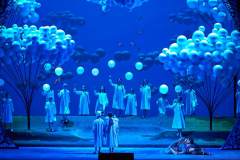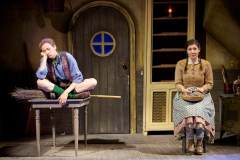Hansel and Gretel
January 2026 | ||||||
|---|---|---|---|---|---|---|
Mo | Tu | We | Th | Fr | Sa | Su |
Hansel and Gretel – Engelbert Humperdinck | Opera
Fairy Tale Play in Three Acts
Text by Adelheid Wette
Scene 1 & 2 - 60 min
Intermission - 20 min
Scene 3 - 45 min
Storyline
Prologue
London, Christmas around 1890: a Victorian family gathers comfortably around the Christmas tree in the living room.
The father surprises everyone with a mysterious new device, a magic lantern, which projects all kinds of unknown and wonderful images onto the wall and at the same time opens the door to a strange, fairytale world ...
Scene 1
Instead of doing their assigned chores, the hungry siblings Hansel and Gretel pass the time singing and dancing in their miserable hut at home.
They eagerly await the evening and the return of their parents, because this time there will finally be something to eat before they go to bed: The two children hope that their mother will cook a rice porridge from the milk that a neighbor has brought as a gift. But when their mother finally comes home, the mood suddenly changes.
Furious that Hansel and Gretel have spent the day playing together instead of tying brooms and knitting stockings, she rushes towards the children to beat them up. In the process, she accidentally knocks the pot of milk off the table. Hänsel's giggles at her mischief, the broken pieces on the floor and the spilt milk make the mother lose her head - she drives the children out into the neighboring forest to pick strawberries. Left alone, she complains about her family's poverty and hunger and falls asleep tired.
She is woken up by her cheerful, somewhat inebriated husband who, for once, has been able to sell all his goods and has acquired a large stock of all kinds of food from the proceeds. But the joy is short-lived - dismayed that his children have been sent out alone, he tells his wife about the man-eating crispy witch on the Ilsenstein, a particularly dark and disreputable place in the forest. Full of worry, the parents rush out of the hut to find Hansel and Gretel before nightfall and bring them home.
Scene 2
While Hansel collects strawberries and fills the basket to the brim, Gretel winds a wreath.
Happy to have done their mother's bidding this time, they lose themselves in all kinds of games and forget to go home on time. To make matters worse, the two of them eat all the strawberries they have collected, one by one, without realizing it.
When Hansel and Gretel are terrified and want to look for new ones, they realize that they have lost their way in the dark of the forest. Then the good Sandman appears and sprinkles sand in their eyes. Closely embraced, Hansel and Gretel fall asleep after evening prayers. In a beautiful dream in which 14 angels float past, they are given a reassuring glimpse of death and new life.
Scene 3
The next morning, Hansel and Gretel are woken up by the Taumännchen and discover the witch's crispy house. When Hansel breaks off a piece of the crispy house, the witch's voice can be heard from inside.
However, as nothing else threatening happens, the children start snacking on the little house until the witch comes out. Although she appears friendly at first, her true face is soon revealed: she casts a spell on Hansel and Gretel and locks Hansel in a cage to fatten him up.
In exuberant anticipation of eating the children, the witch mounts her broom and, sitting on it, flies through the air for some time in great ecstasy. After her witchy ride, she tries to persuade Gretel to look into the oven. Her plan to push the unsuspecting girl into the oven and bake her into a gingerbread cake fails because Gretel, warned by her brother, plays dumb and asks the witch to show her how to look into the oven. The witch impatiently agrees to Gretel's suggestion and leans far into the oven.
At this moment, Hansel and Gretel push her inside and she dies miserably. As soon as the witch is dead, the numerous gingerbread men who had been standing around the crunchy house become living children. They had all once fallen into the clutches of the witch and been turned into gingerbread in the oven. But now the spell is broken. Hansel and Gretel caress the children and break the final spell with the help of the magic wand: the grateful children dance around their two rescuers in jubilation. A little later, Hansel and Gretel's parents, who had been looking for their children all night, meet the happy flock. Grateful and full of joy, they sing together: "When adversity rises to the highest, the Lord God will have mercy on us!"
Program and cast
Peter Besenbinder - Clemens Unterreiner
Gertrud - Regine Hangler
Hänsel - Alma Neuhaus
Gretel - Maria Nazarova
Knusperhexe - Michael Laurenz
Musical Direction - Cornelius Meister
Production - Adrian Noble
Stage and Costumes - Anthony Ward
Lighting - Jean Kalman
Choreography - Denni Sayers
Video - Andrzej Goulding
Vienna State Opera
Public Transport
Subway lines: U1, U2, U4
Trams: 1, 2, D, J, 62, 65
Buses: 59A
Local Railway: Badner Bahn
Stops: Karlsplatz / Opera
Taxi stands are available nearby.
Parking
Parking is only € 6, - for eight hours!
The Wiener Staatsoper and the ÖPARK Kärntner Ring Garage on Mahlerstraße 8, under the “Ringstraßengalerien”, offer the patrons of the Vienna State Opera a new, reduced parking fee. You can park in the Kärntner Ring Garage for up to 8 hours and pay only a flat fee of € 6, -. Just validate your ticket at one of the discount machines inside the Wiener Staatsoper. The normal rate will be charged for parking time greater than 8 hours. The validation machines can be found at the following coat checks: Operngasse, Herbert von Karajan-Platz, and the right and left and balcony galleries.
Important: In order to get the discount, please draw a ticket and do not use your credit card when entering the garage!
After devaluing your ticket in the Wiener Staatsoper you can pay comfortably by credit card or cash at the vending machines.
The machines accept coins and bills up to 50.- Euro. Parking time longer than 8 hours will be charged at the normal rate.
History
The structure of the opera house was planned by the Viennese architect August Sicard von Sicardsburg, while the inside was designed by interior decorator Eduard van der Nüll. It was also impacted by other major artists such as Moritz von Schwind, who painted the frescoes in the foyer, and the famous "Zauberflöten" (“Magic Flute”) series of frescoes on the veranda. Neither of the architects survived to see the opening of ‘their’ opera house: the sensitive van der Nüll committed suicide, and his friend Sicardsburg died of a stroke soon afterwards.
On May 25, 1869, the opera house solemnly opened with Mozart's Don Giovanni in the presence of Emperor Franz Joseph and Empress Elisabeth.
The popularity of the building grew under the artistic influence of the first directors: Franz von Dingelstedt, Johann Herbeck, Franz Jauner, and Wilhelm Jahn. The Vienna opera experienced its first high point under the direction of Gustav Mahler. He completely transformed the outdated performance system, increased the precision and timing of the performances, and also utilized the experience of other noteworthy artists, such as Alfred Roller, for the formation of new stage aesthetics.
The years 1938 to 1945 were a dark chapter in the history of the opera house. Under the Nazis, many members of the house were driven out, pursued, and killed, and many works were not allowed to be played.
On March 12, 1945, the opera house was devastated during a bombing, but on May 1, 1945, the “State Opera in the Volksoper” opened with a performance of Mozart's THE MARRIAGE OF FIGARO. On October 6, 1945, the hastily restored “Theaters an der Wien” reopened with Beethoven's FIDELIO. For the next ten years the Vienna State Opera operated in two venues while the true headquarters was being rebuilt at a great expense.
The Secretary of State for Public Works, Julius Raab, announced on May 24, 1945, that reconstruction of the Vienna State Opera would begin immediately. Only the main facade, the grand staircase, and the Schwind Foyer had been spared from the bombs. On November 5, 1955, the Vienna State Opera reopened with a new auditorium and modernized technology. Under the direction of Karl Böhm, Beethoven’s FIDELIO was brilliantly performed, and the opening ceremonies were broadcast by Austrian television. The whole world understood that life was beginning again for this country that had just regained its independence.
Today, the Vienna State Opera is considered one of the most important opera houses in the world; in particular, it is the house with the largest repertoire. It has been under the direction of Dominique Meyer since September 1, 2010.

 EN
EN DE
DE IT
IT FR
FR ES
ES RU
RU JP
JP RO
RO
 Seating plan
Seating plan 
